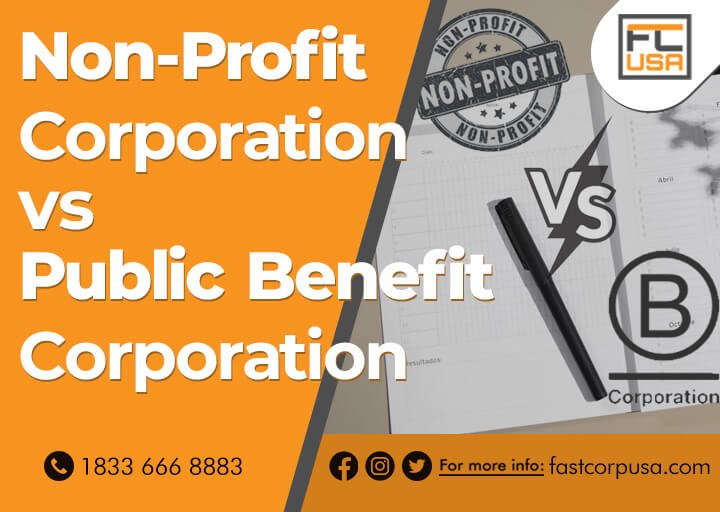Entrepreneurs & people are at a crossroads in the corporate, where they want to establish a public service firm that generates profit. Two financial structures can accomplish their aim: (1) Public Benefit Corporations “PBC,” and (2) Non-profit Corporations “NPC.”
PBCs and NPCs serve charitable purposes. They are separate firms; the only difference is that PBCs get their profit, too. The decision to establish PBC comes from generating profit in a non-traditional way while addressing socio-economical issues.
This article serves as thorough information on public benefit vs. non-profit corporations. It focuses on its structures, taxation, and fundraising points to make you priorly aware of the establishment and challenges.
Non-Profit Corporation VS Public Benefit Corporation
A Non-profit corporation (NPC) is a business formed to serve the people and for the betterment of society. Unlike other businesses whose main objective is to earn a profit, it gets no benefits. Meanwhile, the Public Benefit Corporation, also known as a B-Corporation, is a company that generates profit.
The main purpose of a non-profit is to provide goods and services to the public. It has no owners, but their help to people includes charitable, educational, religious, or other public services, without expecting to earn profit. However, the profit that a Public Benefit Corporation makes gets distributed among the shareholders as a dividend in the company.
A public benefit corporation is a type of business that works not only for public goods and services but also for its profit. It lies in Delaware General Corporation. The incorporation certificate of the public-benefit company must have to agree to spend their specific profit on people.
This means if a person is investing in a Public Benefit Corporation, he is not only gaining profit but also working for the betterment of society.
Core Difference Between Non-Profit Corporations and Public Benefit Corporations
Even though there is a similarity in both corporations’ purposes. They aim to provide benefits to the public, serve them, and work for the betterment of the world. But there are other key differences from its formation to dissolving issues.
1. Formation Differences
Forming a Non-profit Organization requires a lot of paperwork but is a two-step process.
- Choosing the purpose for the formation (like educational, charitable, library, or educational) and the name is the first step of a Non-Profit Corporation.
- If the corporation’s mission meets the requirements of the IRS, they will state that in their certificate of Incorporation.
- Submit the appropriate application for tax-exempt status to the IRS in the form of IRS Form 1023. The duration of application submission is 15 months from the company formation. (If the application is denied, the corporation can appeal).
- Once the IRS approves the corporation, exempting the income, sales, and property taxes at the state and local levels will be easier.
Important note: Whatever the application states, the corporation needs to make sure it operates in the same way to maintain the credibility of the company.
On the other hand, forming a Public Benefit Corporation is more manageable than forming a Non-Profit corporation. It is similar to the traditional process for a profit corporation.
- You must submit the Delaware Incorporation Certificate for a public benefit corporation. The certificate should declare the clause of public benefit in the status of an organization.
- The PBC may be primarily involved with profitable companies, irrespective of their stated reason, like food manufacturing, real estate, and any other. But the certificate must be filed with the shareholders voting with the majority of two-thirds votes.
Note: The Certificate of Incorporation of PBCs states that some of its profit will be used for the benefit of the public
You can form public benefit corporations in any state like Texas, California, and many others. So, choose your state of corporation according to taxes, structure, and a few other factors mentioned below.
2. Ownership Differences
Since there are no shareholders in Non-Profit Corporations, there is no ownership in these corporations. All the decisions and affairs are overseen by their Board of Directors. People gift money and services to the NPCs, but they don’t expect anything in return.
Meanwhile, PBCs have shareholders or stockholders who invest in the company and get profit in return. It has the owners of the company. However, they are still not the ones responsible for making decisions.
By voting, they elect the Board of Directors to take care of the corporation’s internal affairs and decision-making. The officers implement these decisions.
3. Funding & Fundraising Differences
The funding sources of a Non-Profit corporation are mostly donations, government grants, or other fundraising activities. These are the ways a Non-profit corporation raises its money. The individual contributors who get authorization from the IRS 501c company can exclude their donations from regular earnings on federal tax returns.
However, Public Benefit Corporations can raise money in many ways, like every General Profit Corporation. It includes either the profit the organization makes, which is given to the shareholders as a dividend, or when the organization grows.
When the value of the shares increases, shareholders can sell them and make the company profit from them. Other ways include issuing bonds, trading stocks, or borrowing money from the bank. Build Business credit for a small business to get funds and protect the ownership of a Public Benefit Corporation.
4. Reporting on Progress
As Non-Profit Corporations don’t have any owners and shareholders, therefore, they are not responsible for reporting their progress to anyone. However, they do inform for the safe side so that the people who invest and gift money and services to the corporations continue to invest.
Whereas the Public Benefit Corporation in Delaware has to submit a bi-annual report of the progress to its shareholders and other investors. The report must include the details of corporation benefits and progress according to the objective in the incorporation certificate.
The report is not supposed to be shared publicly but must be shared with the corporation’s owners.
5. Taxation Differences
If a General Profit Company is liable to pay tax as a C-corporation, it must also pay the federal income tax. The company’s shareholders will pay income tax on their profits and earnings. So, be updated with corporate tax rates. But if the corporation gets selected for the S-corporation taxes, its income will go through its shareholders.
If the Organization fulfills the IRS and the State requirements, it becomes a Non-Profit corporation. Those corporations’ major benefit is serving the people and not generating profit; therefore, they don’t need to pay taxes.
Non-profit corporations are tax-exempt under the laws of Federal Income Tax Section 501(c)(3) laws. Non-profit organizations have to submit IRS Form 990, which has a public report section and includes company and board of directors information.
On the other hand, even if the Public Benefit Corporation serves a charitable purpose, it still needs to pay taxes on its profit. Each year, it pays taxes to the IRS using Form 1120. The company’s previously filed tax returns are submitted under Federal Privacy laws.
6. Corporate Profit Distribution
The Public Benefit Corporation shares the generated profit with its shareholders and stockholders as dividends. Meanwhile, a non-profit corporation solely serves the people and environment, so these companies’ profits must be rolled on for more profit generation.
7. Duties of Directors
There are no owners in Non-Profit organizations. So, primarily, its directors are usually the group of individuals governing that. They have to ensure the corporation’s purpose of serving the public is being fulfilled within legal and ethical guidelines.
In Public Benefit Corporations, the Board of Directors is elected by its owners by voting. These directors are responsible for all the internal affairs, decision-making, distribution of dividends, etc. The directors of boards should stay loyal to the organization. They are permitted to buy the shares of the firm.
8. Delaware Franchise Tax Differences
In Delaware, the Non-Profit Organization pays $25 every year along with the bi-annual report. The report includes information on the directors of the board, finance, and other information.
However, the Public-Benefit Corporation in Delaware has to pay franchise tax on the profit a corporation generates. The amount of tax depends on the number of shares a corporation issues.
9. Structure
The structure of the Non-Profit Organization is non-stock, as they have no shareholders and no owners. The corporation is under the board of directors, which is also called the Board of Trustees. The corporation’s bylaws state that the director of boards and members can select their candidates to run the corporation.
The bylaws state the members and their designations to run the non-profit corporation. They can have multiple types of members, which include voting and non-voting.
The Public Benefit Companies in Delaware are organized according to the Delaware General Corporation Laws (DGCL). They have written documents committing themselves to being a public benefit company.
The structure of the corporation has three levels: (1) Shareholders, (2) Directors, and (3) Officers. The company’s hold is under the shareholders as they are the investors. Shareholders elect the Board of Directors annually, whereas directors design policies and terms. Directors are also responsible for hiring officers.
10. Stock Certificates
Public Benefit Corporations must have B-Corp mentioned on their stock certificates. Whereas, Non-Profit Corporations don’t have stock, so there are no stock certificates.
11. Dissolution
In the difficult and emotional process of dissolution, when the Non-Profit Corporation is dissolved, all the assets of the organization will be distributed among other Non-Profit organizations. The reason behind it is that there are no shareholders in the corporation.
But when the Public Benefit Corporation is dissolved, all the remaining asset (after paying off the liabilities) is distributed among its shareholders according to the number of shares they own
Pros and cons of Non-Profit and Public Benefit Organizations
Non-Profit Organizations
| Pros | Cons |
| No tax to pay. | A lot of paperwork, with in-depth maintenance of rules and conditions. |
| Gets discounts as gifts from companies and the Government. | The founder can’t even get profit, as they are for the public and state. |
| Members don’t pay corporations’ liabilities from their assets. | Profits and revenues depend on donations and other fundraising activities. |
Public Benefit Organizations
| Pros | Cons |
| Serve the public and gain profit simultaneously. | You have to pay taxes on income, property, and sales. |
| Attract social service investors for double profit. | It can only be established in some states. |
| BODs make decisions for public benefit even if they have to bear some loss. | Creating a balance between profit and social service can be challenging. |
List of Non-Profit Corporations
The following are some of the names of successful Non-profit corporations.
- American Red Cross
- Habitats for Humanity
- Care
- Ted Talks
- Sierra Club.
- Earthjustice
- Humane Source of the U.S.
- Doctors without Borders
- Meals on Wheels
- The United Way
- Boys Scouts & Girls Scouts.
- Save the Children
- Human Rights Campaign.
- Direct Relief
- Avon Foundation
- World Vision
- Susan G. Komen Breast Cancer Foundation
- Museum of Modern Art.
- World Wildlife Fund.
List of Public Benefit Corporations
A few names that are included as Public Benefit Corporations are:
- Moodle
- Patagonia
- Kickstarter
- Method
- Gousto
- Envato
- Ben and Jerry’s
- Warby Parkers
- Body Shop
- Toms
- King Arthur Flour
- Coursera
FastCorpUSA for the Legal Assitance in your Public Benefit and Non-Profit Corporation
Whether you are looking for assistance in the formation of a public benefit corporation or a non-profit corporation in Delaware, the experts of FastCorpUSA will assist you. Our team focuses on legal proceedings and will help you in the formation of a C-corporation. Our research team stays up to date with every practicing rule and condition in the country. Contact us at “(1833) 666 8883” or email at info@fastcorpusa.com.





0 Comments